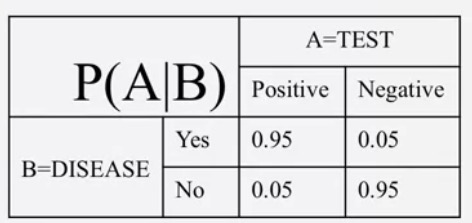Week6-2Bayesian theorem
2015-12-16 11:57
288 查看
Bayes’ theorem
Formula for joint probabilityP(A,B)=P(B∣A)P(A)=P(A∣B)P(B)
Therefore
P(A∣B)=P(B∣A)P(A)P(B)
Example
We have the following table.
What is p(disease∣positive)?
P(disease∣positive)=P(positive∣disease)P(disease)P(positive)P(¬disease∣positive)=P(positive∣¬disease)P(¬disease)P(positive)We don’t care what value P(positive) is, as long as it is larger than 0.
P(disease∣positive)P(¬disease∣positive)=P(positive∣disease)P(disease)P(positive∣¬disease)P(¬disease)
So P(disease) is crucial for the final ratio. Suppose P(disease)=0.001, and we would have
P(disease∣positive)P(¬disease∣positive)=0.95×0.0010.05times0.999=0.019P(disease∣positive)+P(¬disease∣positive)=1
Very low! we cannot compensate too much the prior even if the test is positive, only from 0.1% to about 2%, still far from 50%.
相关文章推荐
- 那些年Android开发中遇到的坑
- 拨号过程中显示“Unknown Caller”
- hibernate 用表维护主键
- SQL Server 中心订阅模型(多发布单订阅)
- 磕磕绊绊配置linux 下 laravel5.1 环境
- 那些年Android开发中遇到的坑
- 分段式RadioGroup
- MySQL表LEFT JOIN左连接与RIGHT JOIN右连接的实例教程
- 打印出所有的"水仙花数",所谓"水仙花数"是指一个三位数,其各位数字立方和等于该数本身。
- spring tool suite 的编码设置
- 各种字符编码方式详解及由来(ANSI,UNICODE,UTF-8,GB2312,GBK)
- jQuery自定义函数验证邮箱格式
- cocos2dx - tmx地图分层移动处理
- BZOJ1930: [Shoi2003]pacman 吃豆豆
- log4j 应用
- 类hive 系统高并发去,添加partition,同时紧跟tunnel去写数据的坑
- 判断101-200之间有多少个素数,并输出所有素数。
- hdu 1013 Digital Roots【数根计算 余九解法】
- redis高级特性之主从复制
- 末日即将来到,T-800 终结者内核版本 Linux 4.1.15 出现!
